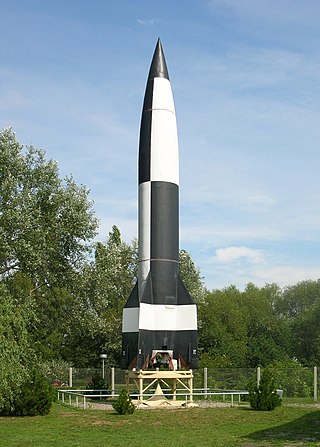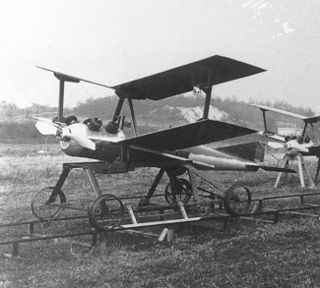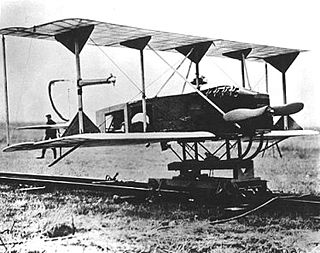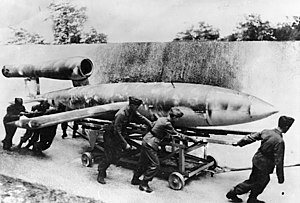Historic exemplars
The Sphere of March 13, 1915 published an article on "The Possibilities of an Aerial Torpedo Controlled by Wireless", suggested by a "correspondent to the Sphere" and declared feasible by an "aviation expert".
The first attempt to build a flying bomb (alternatively called an "aerial torpedo" in the Navy) was undertaken by Elmer Sperry for the US Navy in 1916, called the Hewitt-Sperry Automatic Airplane, and was based on a Curtiss N-9 seaplane. This led to a mission-specific Curtiss design, the Curtiss-Sperry Flying Bomb, which was almost completely unsuccessful. The US Army also tried to develop a flying bomb in World War I, the Kettering Bug, but the war ended before the program could mature. The functioning but unsuccessful German Mistel flying bomb was essentially an enormous shaped charge mounted on a repurposed twin-engined medium bomber's airframe (most often a Junkers Ju 88) in place of the cockpit, that was guided by a fighter sitting on top. The fighter first took a course towards the target, then released the Mistel which would continue to its target. The best known example of a flying bomb is the German V-1, many of which targeted London in 1944 during World War II.

A bomber is a military combat aircraft designed to attack ground and naval targets by dropping air-to-ground weaponry, launching torpedoes, or deploying air-launched cruise missiles. The first use of bombs dropped from an aircraft occurred in the Italo-Turkish War, with the first major deployments coming in the First World War and Second World War by all major airforces causing devastating damage to cities, towns, and rural areas. The first purpose built bombers were the Italian Caproni Ca 30 and British Bristol T.B.8, both of 1913. Some bombers were decorated with nose art or victory markings.

A cruise missile is a guided missile used against terrestrial or naval targets, that remains in the atmosphere and flies the major portion of its flight path at an approximately constant speed. Cruise missiles are designed to deliver a large warhead over long distances with high precision. Modern cruise missiles are capable of traveling at high subsonic, supersonic, or hypersonic speeds, are self-navigating, and are able to fly on a non-ballistic, extremely low-altitude trajectory.

In military terminology, a missile is a guided airborne ranged weapon capable of self-propelled flight usually by a jet engine or rocket motor. Missiles are thus also called guided missiles or guided rockets. Missiles have five system components: targeting, guidance system, flight system, engine and warhead. Missiles come in types adapted for different purposes: surface-to-surface and air-to-surface missiles, surface-to-air missiles, air-to-air missiles, and anti-satellite weapons.

A military aircraft is any fixed-wing or rotary-wing aircraft that is operated by a legal or insurrectionary military of any type. Military aircraft can be either combat or non-combat:

A dive bomber is a bomber aircraft that dives directly at its targets in order to provide greater accuracy for the bomb it drops. Diving towards the target simplifies the bomb's trajectory and allows the pilot to keep visual contact throughout the bomb run. This allows attacks on point targets and ships, which were difficult to attack with conventional level bombers, even en masse.

Heavy bombers are bomber aircraft capable of delivering the largest payload of air-to-ground weaponry and longest range of their era. Archetypal heavy bombers have therefore usually been among the largest and most powerful military aircraft at any point in time. In the second half of the 20th century, heavy bombers were largely superseded by strategic bombers, which were often even larger in size, had much longer ranges and were capable of delivering nuclear bombs.

A fighter-bomber is a fighter aircraft that has been modified, or used primarily, as a light bomber or attack aircraft. It differs from bomber and attack aircraft primarily in its origins, as a fighter that has been adapted into other roles, whereas bombers and attack aircraft are developed specifically for bombing and attack roles.

Aerial warfare is the use of military aircraft and other flying machines in warfare. Aerial warfare includes bombers attacking enemy installations or a concentration of enemy troops or strategic targets; fighter aircraft battling for control of airspace; attack aircraft engaging in close air support against ground targets; naval aviation flying against sea and nearby land targets; gliders, helicopters and other aircraft to carry airborne forces such as paratroopers; aerial refueling tankers to extend operation time or range; and military transport aircraft to move cargo and personnel.

The history of aerial warfare began in ancient times, with the use of kites in China. In the third century, it progressed to balloon warfare. Airplanes were put to use for war starting in 1911, initially for reconnaissance, and then for aerial combat to shoot down the recon planes. The use of planes for strategic bombing emerged during World War II. Also during World War II, Nazi Germany developed many missile and precision-guided munition systems, including the first cruise missile, the first short-range ballistic missile, the first guided surface-to-air missiles, and the first anti-ship missiles. Ballistic missiles became of key importance during the Cold War, were armed with nuclear warheads, and were stockpiled by the superpowers – the United States and the Soviet Union – to deter each other from using them.
Kampfgeschwader 200 was a German Luftwaffe special operations unit during World War II. The unit carried out especially difficult bombing and transport operations and long-distance reconnaissance flights, tested new aircraft designs and operated captured aircraft.

A parasite aircraft is a component of a composite aircraft which is carried aloft and air launched by a larger carrier aircraft or mother ship to support the primary mission of the carrier. The carrier craft may or may not be able to later recover the parasite during flight.

Wunderwaffe is a German word meaning "wonder-weapon" and was a term assigned during World War II by Nazi Germany's propaganda ministry to some revolutionary "superweapons". Most of these weapons however remained prototypes, which either never reached the combat theater, or if they did, were too late or in too insignificant numbers to have a military effect.

UAVs include both autonomous drones and remotely piloted vehicles (RPVs). A UAV is capable of controlled, sustained level flight and is powered by a jet, reciprocating, or electric engine. In the twenty first century technology reached a point of sophistication that the UAV is now being given a greatly expanded role in many areas of aviation.

The Kettering Bug was an experimental unmanned aerial torpedo, a forerunner of present-day cruise missiles. It was capable of striking ground targets up to 75 miles (121 km) from its launch point, while traveling at speeds of 50 miles per hour (80 km/h). The Bug's costly design and operation inspired Dr. Henry W. Walden to create a rocket that would allow a pilot to control the rocket after launch with the use of radio waves. The British radio controlled weapons of 1917 were secret at this time. These designs were forerunners of modern-day missiles.

The Hewitt-Sperry Automatic Airplane was a project undertaken during World War I to develop a flying bomb, or pilotless aircraft capable of carrying explosives to its target. It is considered by some to be a precursor of the cruise missile.

An aerial torpedo is a torpedo launched from a torpedo bomber aircraft into the water, after which the weapon propels itself to the target.

The Royal Aircraft Establishment Larynx was an early British pilotless aircraft, to be used as a guided anti-ship weapon. Started in September 1925, it was an early cruise missile guided by an autopilot.

Project Kingfisher was a weapons-development program initiated by the United States Navy during the latter part of World War II. Intended to provide aircraft and surface ships with the ability to deliver torpedoes to targets from outside the range of defensive armament, six different missile concepts were developed; four were selected for full development programs, but only one reached operational service.
A composite aircraft is made up of multiple component craft. It takes off and flies initially as a single aircraft, with the components able to separate in flight and continue as independent aircraft. Typically the larger aircraft acts as a carrier aircraft or mother ship, with the smaller sometimes called a parasite or jockey craft.

















